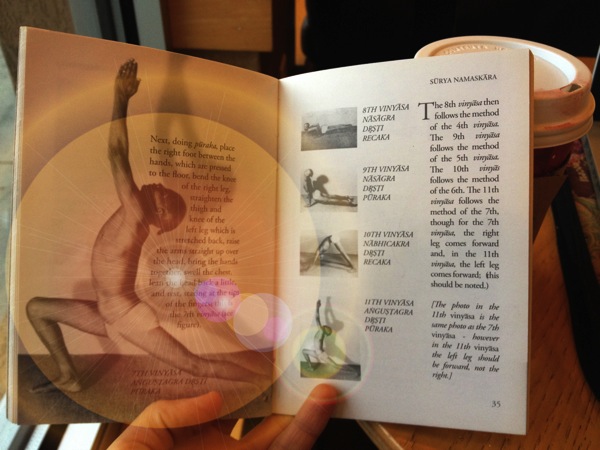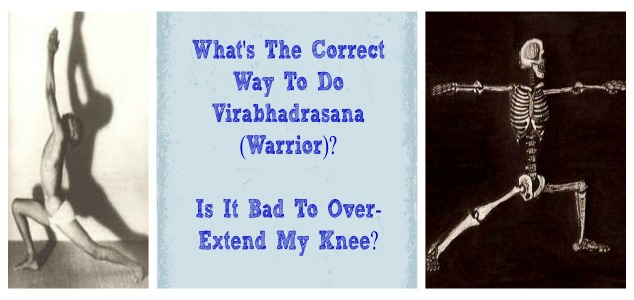For the record, I don’t think Sharath has bad form. That was just to get your attention, and it looks like it worked (YES!!). This YouTube video of Sharath came out a few months ago and caused a lot of criticism and judgement in the Ashtanga community about form and alignment. I watched the videos and message boards, and people were very confused about the alignment because he over extends the knee in Virabhadrasana I & II.
When I first watched it, I wondered the same thing, but I didn’t spend enough time caring to have Sharath bashing conversations. Also, I have no beef with Sharath. I pretty much remained silent, but that doesn’t mean I wasn’t a little curious.
I wondered, Why has it been ingrained all of these years to keep your knee over your ankle, and here Sharath is contradicting it?
Then, I realized that I didn’t even know why my knee shouldn’t extend over the ankle. I was always told it was “bad” or “wrong,” but had nothing factual to back it up. I grabbed Ashtanga Yoga: Practice and Philosophy and John Scott’s Ashtanga Yoga Guide
to reference, and they both teach it with knee over ankle.
Then, I remembered that I had Surya Namaskara, the little book by Patttabhi Jois, which gives step-by-step directions on the vinyasas and form, so I rummaged through all of my books and was frustrated that I couldn’t find it. That was a few months ago, so I let it go, and forgot about it until now when I found it in a little basket covered with papers as I was doing my 2014 closet cleaning extravaganza!
I stopped everything, and I quickly turned to the instructions on Surya Namaskara. I was surprised and somewhat excited to see that Pattabhi Jois is doing the same thing with his knee! Look at how deep his lunge is here and how over extended his knee is?!?!

Side Note: I’m loving using PicMonkey (AWESOME!)! The free version is great, but now that I upgraded, I can do these awesome effects like in the pic above. So rad!
The reason I was a little excited that he had his knee extended was because I feel like people just like to give Sharath a hard time. I could be wrong, but if it was Guruji in that video, and not Sharath, would the uproar and criticism have been the same?
I grew up doing gymnastics and I was always taught to not over extend the knee, but we all know that Yoga is not gymnastics, and that yoga teaches to look beyond the physical and contradicts much of what we learn in exercise or other physical activities.
Actually, everything in yoga is about looking beyond the physical realm and proving that the impossible is possible. My favorite part of Surya Namaskara is where Jois mentions that he wants “this booklet to point practitioners in the direction to avoid becoming deluded by the allure of physical accomplishments.”
I decided to do some deeper research on why we shouldn’t extend the knee over the ankle, so I looked into Ray Long’s The Key Muscles of Yoga and The Key Poses of Yoga
(Two great books, btw), but they only show me how to do the posture and what muscles are being active and passive. It doesn’t tell me why specifically I must do the posture that way.
I obviously wasn’t getting anywhere with all of the books I’ve invested in, so I decided it was time to use Google. Google has all of the answers, right??
I found this article from Ace Fitness, where they mention:
[color-box=”blue”]”It is correct to avoid excessive forward movement of the knee during squatting and lunging movements. It is a myth, however, that you should never let your knees go past your toes while doing a squat or lunge. This belief originated from a study that is more than 30 years old (1978 Duke University study that found maintaining a vertical lower leg as much as possible reduced shearing forces on the knee during a squat). The truth is that leaning forward too much is more likely what is truly causing the problem or injury.
The general pointer while performing a lunge is to try to keep your knees aligned over your second toe so that the knee is moving in the same direction as the ankle joint. However, in reality we often find the knee translating (moving) forward to the toes or beyond in a squat or lunge movement, so there are other things that must be considered. The reason for this can be attributed to the length of limbs (shinbones or tibia/fibula and the thigh bone or femur).“[/color-box]
Then they go on to talk about how teaching it this way originated more to err on the side of caution for large gym classes where fitness instructors could not give everyone attention. I also found it interesting when the article mentioned that “hip stress increased nearly 1,000% when forward movement of the knee was restricted.”
…and then this article by Matt Fitzgerald: Fitness Myth: Don’t Pass Your Toes
[color-box=”purple’]This caution is actually 100 percent false. A myth without a shred of truth to it. One of those classic fitness fallacies that emerges from the exercise-is-dangerous mentality that pervades the fitness club culture and becomes “true” by repetition, as “expert” after expert hears it and then repeats it without ever questioning it. But the knees-over-toes rule is in fact based on nothing substantive — not on any evidence of a link between squat or lunge form and injury nor even on any anatomical rationale. Worse, the rule is not merely useless but potentially harmful. Ironically, unnatural efforts to keep your knees behind your toes when you squat or lunge are far more likely than the opposite to hurt you.
Allowing the knee to pass in front of the toe when squatting or lunging is completely natural. Humans do it automatically from the time they are old enough to squat down to pick up a ball. Ask any two-year-old to do that and watch her knees.“[/color-box]
One thing that was a commonality in both articles is that they say, it’s a matter of individual ability, anatomy, and skill. Fitzgerald says it best:
“Not everyone should aim to get their knees past their toes when squatting or lunging. However, it’s a matter of individual anatomy. People with shorter legs often squat and lunge quite naturally without excursion of the knees beyond the toes. Taller folks tend to naturally push the knees beyond the toes. You need to let your individual body move as it was designed to do.
So there you have it! It’s not bad form, but just based on individual anatomy.
For a long time I was one of those, “what’s the right way to do it” people. I had so many questions…. Did they change it? Why did it change? Why does this teacher teach it one way, but that teacher teaches it another? What’s the right way? How do they do it in Mysore?
I realized eventually that yoga is all about breaking down those walls and illusions. Sometimes, it’s about making a small adjustment to what works for you. I asked myself, “will I not find enlightenment if I let my knee over extend,” and then realized how silly that sounded, and how much time I was wasting on the physical aspects. Typical Type A, right!
This made me question everything about what has been ingrained and drilled into the teachings about form and alignment. Maybe that’s what Jois was trying to say when he mentions, “to avoid becoming deluded by the allure of physical accomplishments.”
Maybe we all put to much of an emphasis on grasping to one right way vs. using yoga as a tool to achieve clarity of mind and spiritual elevation? Yoga is all about self inquiry and questioning, but are we spending too much time on the physical and material aspects? The foundation of this practice is vinyasa, and the tristana, so how can we shift the thinking and teaching of the physical aspects to align with the inner meaning?


Leave a Reply